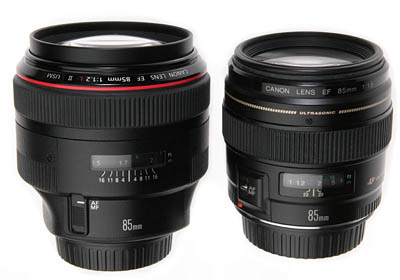 Canon EF 85mm f/1.2L II (left) and EF 85mm f/1.8 |
Externally, the Mark I and Mark II EF 85mm f/1.2L lenses look
identical. Lenses used in test:
|
I could have given this review the title, "In Praise of the EF 85mm f/1.8 Lens." It does almost everything that the EF 85mm f/1.2 L does faster, cheaper, lighter and smaller. There are a few notable exceptions. The 1.2L lens gathers more light, and it produces outstanding diffuse background blur (bokeh) and an associated exceedingly narrow plane of focus that can produce a unique look that is very attractive for portraits and useful in many indoor sports/action photography applications. However, unless you have a need to shoot at apertures wider than f/2 (f/1.4 or f/1.2) and/or are a portrait photographer, the EF 85mm f/1.8 lens will meet almost all of your needs for a fast 85mm lens.
With the introduction of the EF 85mm f/1.2L Mark II, Canon has made major improvements in their legendary f/1.2L lens including:
 Canon EF 85mm f/1.2L II (left) and EF 85mm f/1.8 |
Externally, the Mark I and Mark II EF 85mm f/1.2L lenses look
identical. Lenses used in test:
|
Lens Resolution Tests on Film
Resolution curves on film for the three lenses can almost be superimposed upon each other. Small differences in recorded resolution are not photographically significant when you consider the variable effects of autofocus error. That is, any slight differences in resolution between lenses probably has less effect than autofocus error and photographer error under most conditions.
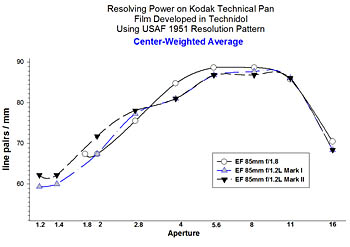 |
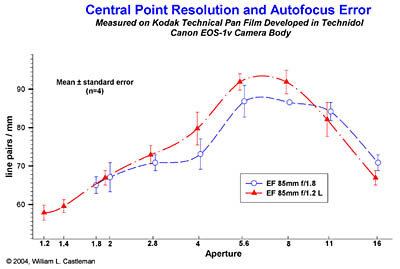 |
|
| Methodology for the resolution test is here. | All autofocus camera bodies have autofocus error. The above test was run with the EF 85mm f/1.2L mark I and the EF 85mm f/1.8 lenses. In tests with the Mark I and Mark II f/1.2L lenses, autofocus error was closely comparable with an EOS-1v body. |
Note on autofocus accuracy: I have read
accounts on the internet of inaccurately focusing EF 85mm f/1.2L lenses
and specific comments on the mark II. I have owned 4 copies of the mark I
f/1.2L and extensively tested my current mark II. All lenses have
autofocused flawlessly within the limits of camera-based autofocus
variability. The mark II lens has autofocused accurately with the
following cameras: EOS-1D Mark II, EOS-1Ds Mark II, EOS-1v, EOS 20D.
Note
on lens to lens variability: Of the 5 85mm f/1.2L lenses I have owned,
3 were purchased new and 2 lenses were purchased used/refurbished. Film
resolution curves of the 3 new lenses could be superimposed upon one
another. The two used lenses gave very poor film resolution tests that
couldn't be improved by step focusing (i.e., problems weren't autofocus
related). The refurbished lens purchased from a highly reputable dealer
had to be stopped down to f/8 to produce a sharp image (you could see lack
of sharpness in images of news print). The used lens had to be stopped
down to f/4 to produce useable images. The EF 85mm f/1.2L lens is heavy
and complicated lens and probably subject to lens misalignment if dropped.
While I have no evidence of factory-based quality variablity, used copies
in cosmetically like-new conditions vary in quality. It is wise to test
the sharpness of an 85mm f/1.2L lens when you received it and to have a
return option with the buyer if it is found to be damaged/misalighned upon
receipt.
Lens 50% MTF and Contrast with EOS-1Ds Mark II
50% MTF (modulation transfer function) or microcontrast and contrast at 10 lpm (line pairs per mm) were compared among the three lenses using a Canon EOS-1Ds Mark II body. Images for this review were shot in RAW mode and converted to tif images for analysis using Phase One Pro software.
Click here for methodology in determining 50% MTF and Contrast
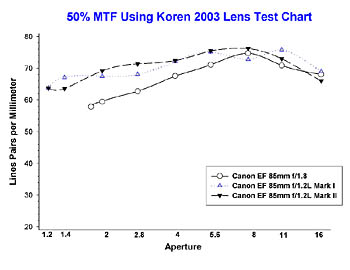 Center-Weighted 50% MTF Center of Lens and Edge of Lens Field Performance |
Center Weighted Contrast at 10 lpm Center of Lens and Edge of Lens Field |
|
| Perceived image sharpness is more closely related to the spatial
frequency (lp/mm) where MTF is 50% (i.e., where contrast has dropped by
half) than to resolution alone. The 50% MTF values were calculated
according to this method
using EOS-1Ds Mk II images converted from RAW. |
Image contrast at 10 lpm. The 1.2L lens outperforms the 1.8 lens in this analysis. Differences between the mark II 1.2L and the Mark I are not associated with detectable differences in image sharpness and contrast. |
Other Tests on Vignetting, Edge Sharpness, Chromatic Aberration
Are differences in 50% MTF and Contrast Visible in Photographs?
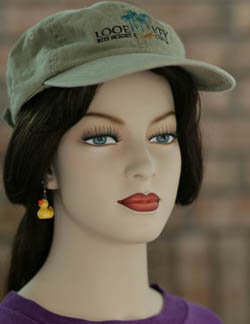 Visible Contrast and Sharpness Differences (Full Table for all 3 lenses from f/1.2 to f/8)) |
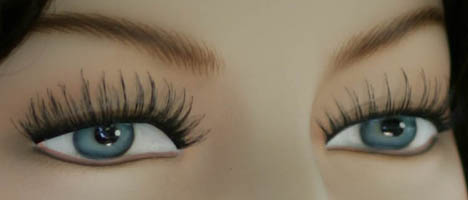 Eye Detail at f/2 for the f/1.2L and f/1.8 Lenses |
Differences in contrast and sharpness are barely detectable at f/2 between the f/1.8 lens and the 1.2L lenses. However, at other apertures differences are not visible. In repeated tests, there were no consistent differences detectable in constrast and sharpness between images produced by the mark I and mark II 1.2L lenses except for differences that were attributable to flare in the mark I lens.
Autofocus Function
In my tests, the mark II f/1.2L was approximately twice as fast as the
mark I lens in autofocusing. (Canon specifies 1.8x faster focusing speed
in the mark II over the mark I). Details: the EF 85 f/1.2L mark I
takes approximately 1 second to re-focus from infinity to 2 meters. The
Canon f/1.8 lens takes approximately 1/8 to 1/4 second. The EF 85mm f/1.2L
II lens takes approximately 1/2 second.
Improved Autofocus
Function of the EF 85mm f/1.2L II Lens Assessed at 2006 NCAA Women's
Gymnastics Championships
The 1.8x increase in autofocus speed of
Mark II lens makes it better suited for gymnastics photography.
Previously, I had been very reluctant to use the mark I EF 85mm f/1.2L
lens for floor events and uneven bars because of its slow autofocus speed.
I missed critical shots. The mark II was sufficiently fast to photograph
gymnasts at the 2006 NCAA Women's Gymnastics Championship on floor and
uneven bars. Other photographers shooting faster action sports such as
basketball may find the Mark II f/1.2L to be too slow since it still only
autofocuses about half as fast as the f/1.8 lens.
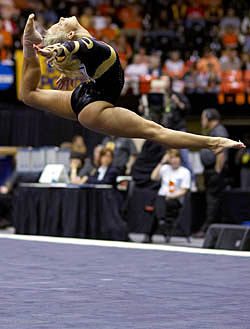 |
April Burkholder, Louisiana State
University 2006 NCAA Championship Floor Exercise Canon EOS-1D mkII, EF 85mm f/1.2L II lens@f/2 ISO 800 1/800 sec |
Out of Focus Background Blur (Bokeh) and Background Out of Focus Diaphragm Pattern
| Controlled Comparison of Out of Focus Background Blurring and Contrast (click here) |  |
In addition to demonstrating background blur and aperture diaphragm
patterns, the photograph
series shows the decrease in contrast in images produced by the Mark
I 1.2L lens associated with flare (f/8 and f/16)
Effect of Round Aperture Diaphragm in the EF 85mm f/1.2 II
The primary effect of rounded aperture diaphragm in the Mark II lens is to round diaphragm patterns in out of focus background lights. This effect is most noticeable at apertures wider than f/2.8.
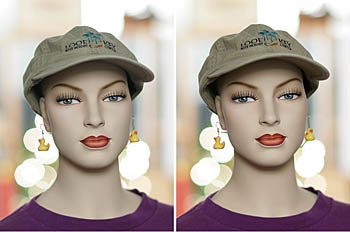 |
f/1.4 |
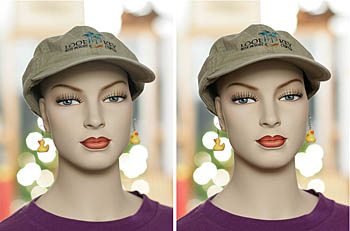 |
f/2.0 |
Improved Lens Coatings in
the EF 85mm f/1.2 II Greatly Reduce Flare and Internal Reflections
Images
are exposed by monolight flash at 1/250th second with a monolight with
snoot firing into the lens in the background.
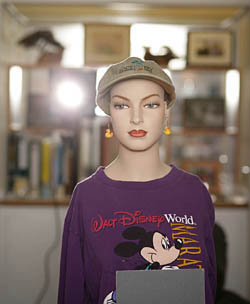 |
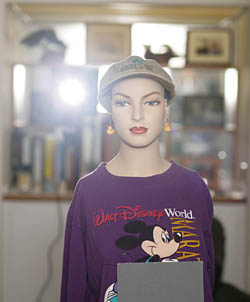 |
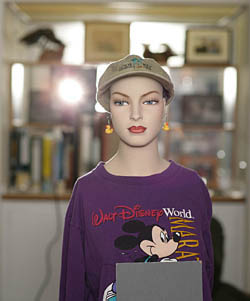 |
| EF 85mm f/1.8 @ f/2.8 | EF 85mm f/1.2L Mark I @ f/2.8 | EF 85mm f/1.2L Mark II @ f/2.8 |
Birefringence (purple fringing) produced by the 3 lenses
Birefringence patterns produced from f/1.4 to f/4 with the 3 lenses on an EOS-1Ds Mark II are shown here. No differences among the lenses were detected in birefringence induced in metallic/reflective objects at wide apertures with the three lenses using the 1Ds Mark II or an EOS 20D (20D images not shown).
Portrait Application
The EF 85mm f/1.2 L lens is prized by portrait photographers for its ability to produce diffuse background blur with the subjects popping out of the blur. This effect is created at apertures from f/1.2 to f/1.4. It has little to do with high MTF performance or high resolution in this aperture range. The narrow plane of focus with average resolution and contrast against a low-contrast, blurred background creates the stunning visual effect.
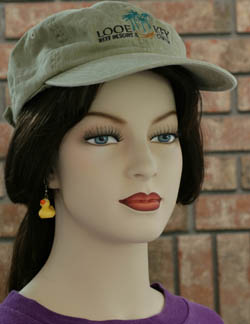 f/8 |
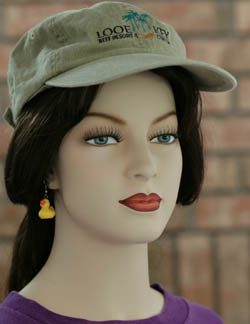 f/2.8 |
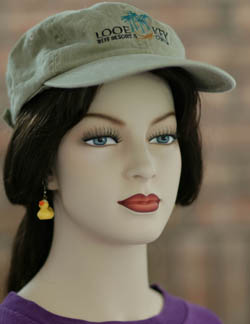 f/1.4 |
Conclusions
You should draw your own conclusions based on your photographic objectives and the need for light gathering capacity, background blur in out of focus areas (bokeh), and for autofocus speed as well as cost and weight considerations.
Canon EF 85mm f/1.2L II (Mark II)
Strengths:
This lens along with the original mark I f/1.2L lens produces excellent
out of focus background blur (bokeh). Combined with super-shallow depth of
focus and the greatest light gathering capacity at f/1.2, it offers
capabilities that other lenses cannot match for low-light photography and
artistic portraits with stunning appearance and for blurring backgrounds
in other applications. Mark II autofocus function has been improved
compared to the mark I lens, and autofocus is perfectly adequate for many
action photography applications. The mark II lens is very resistant to
flare because of its improved lens coatings.
Weaknesses/Challenges:
This lens weighs 2.4 times more, costs 6.2 times more and focuses only
about 1/2 as fast as the EF 85mm f/1.8 lens. The greater weight and
significantly slower autofocus function than the f/1.8 lens may make it a
challenging tool for some action/performance photography applications such
as basketball.
Canon EF 85mm f/1.2L (Mark I)
Strengths:
For most portrait applications of the EF 85mm f/1.2L lens, the Mark I lens
has optical performance that is roughly equivalent to the Mark II lens.
Exceptions are minimal differences in background out of focus lighting
patterns and the absence of electronics to support E-TTL II flash
function. At the time of the review, there are stocks of new mark I lenses
available that are significantly less expensive than the Mark II lenses.
Many high quality Mark I lenses are available in the used market at
excellent price.
Weaknesses/Challenges:
In addition to higher weight and cost issues, the Mark I f/1.2L lens
autofocus is only about 1/4 as fast as the EF 85mm f/1.8 lens. Application
of the mark I to action/performance photography can be very challenging
due to sluggish autofocus. The Mark I lens is very prone to flare compared
to either the Mark II f/1.2L lens or the f/1.8 lens.
Canon EF 85mm f/1.8
Strengths:
Overall, this is an incredibly sharp and good contrast lens with superior
autofocus function in either single focus acquisition or tracking focus
mode. Out of focus blur at f/2 (bokeh) is very pleasing for an 85mm lens.
It is a very light and compact lens that provides high performance at a
relatively inexpensive cost.
Weaknesses/Challenges:
None within the aperture limits of the lens for most photographic
applications. At apertures wider than f/2.8, the f/1.8 lens has slightly
lower contrast and sharpness than the f/1.2L lens.
©
2001-2006, W.L. Castleman
First
Edition Posted 22 August 2001; Second Edition Posted 23 July 2004; Third
edition posted 11 May 2006, updated 15 September 2007